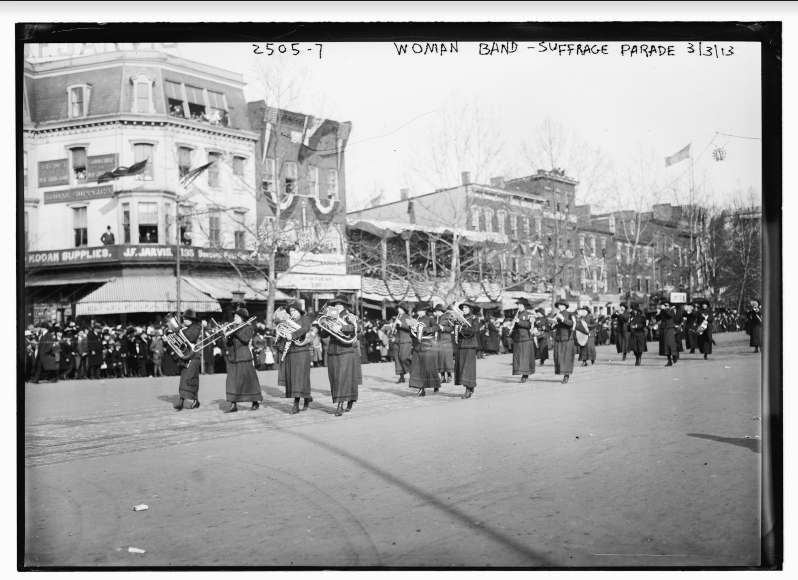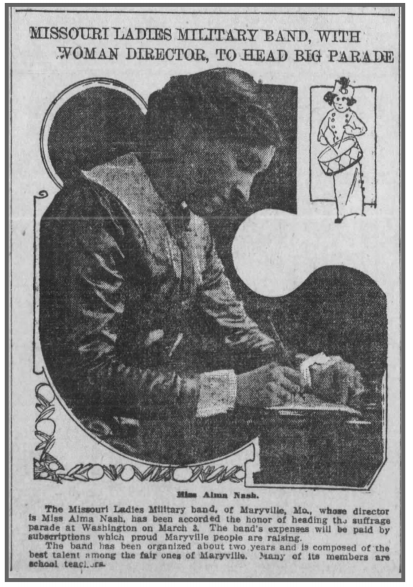
The Missouri Ladies Military Band marching in the parade in Washington DC. One of the uniforms is owned by the historical society and currently is on display at the State Historical Society of Missouri for their Suffrage to Statehood exhibit.
Maryville women fought for the vote
By Dr. Elyssa Ford, Associate Professor of History, Northwest Missouri State University
From the 1870s through the 1920s, women’s suffrage was a frequent topic of debate in Maryville.
Various community organizations invited suffrage leaders like Susan B. Anthony and Elizabeth Cady Stanton to speak in town. Although there was local opposition to women’s suffrage, there also was support for it, demonstrated by the large, enthusiastic crowds they attracted.
The Maryville Republican said of Anthony, “She was listened to throughout her whole lecture with the closest attention, and though many may disagree with her in her conclusions, yet we think that, on the whole, her lecture is calculated to do much good. No one can hear it without being benefited by it.”
In the midst of the invited suffrage speakers, women’s suffrage also appeared in other ways. In the 1880s, the Maryville Republican published a series of anonymous pieces by Dora Dean and responses to her from various groups. Dean focused on suffrage and temperance, and the newspaper became a battleground for these ideas.
Following the 1884 Republican National Convention, she wrote a piece critical of Republicans because “they made no notice of the Women’s Suffrage resolution after it had been read. Unless the party rectifies this wrong, the less said about honesty and parity in the Republican party, the better.”
Shortly after the Dean newspaper debate ended, a group of Nodaway County women suffragists formed a branch of the Equal Rights Association in 1900. This was the first local group created in support of women’s voting rights.
It was this environment in which Alma Nash was born in 1883. After graduating from the Maryville Seminary where she studied string instruments, she travelled the country as a performer. By 1911, she had returned to Maryville and formed an all-women’s band and it was her role as the band’s conductor that brought her directly into the suffrage movement.
In January 1913, Nash and her band inquired about participating in a recently announced Woman Suffrage parade to be held in the nation’s capital. They were accepted and had to quickly raise the travel money, find accommodations, practice the music and learn to march, as they primarily had been a concert band to that point.
On Saturday, March 1, the band left town via railroad. They performed along the way and because the snow in Missouri limited them to indoor rehearsals, they scheduled a stop to practice marching outside. They arrived in DC on Monday morning, just hours before the parade began.
Held on March 3, 1913, the day before Woodrow Wilson’s presidential inauguration, an estimated 5,000 women marched and a half million people crowded the streets to watch. Even though the parade was beset by unruly and sometimes violent crowds, Alma Nash and the Missouri Ladies Military Band enjoyed their experience. Nash explained that the band was placed close to the start of the procession, but was moved even closer to help part the crowds and allow the parade to begin. For the role they played, photographs of Alma Nash and articles about the Maryville band appeared in newspapers across the country.
After the parade, the band toured Missouri county fairs to “soothe the savage beast of man, and charm him thru music into granting the ballot to women.” They also traveled to St. Louis to lead a parade there, just as they had in DC. Their continued fight was needed because just one week after the DC parade, the Missouri legislature voted 16 to 9 against giving women the vote. It was not until July 3, 1919, when Missouri became the 11th state to ratify the Nineteenth Amendment, that Missouri women gained full suffrage.
This article is excerpted from Ford’s “’We Sure Led the Parade’: Alma Nash, the Missouri Ladies Military Band, and the Push for Women’s Suffrage from Rural Missouri to the Nation’s Capital,” Missouri Historical Review 113:3 April 2019: 145-165. The article can be read in full here: digital.shsmo.org/digital/
Nucor-LMP brightens residents’ windows
photo: A resident at Maryville Living Center watches through her window as Nucor-LMP employees install a shepherd hook with a bird feeder.





Facebook Comments